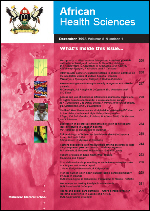
|
African Health Sciences
Makerere University Medical School
ISSN: 1680-6905
EISSN: 1680-6905
Vol. 18, No. 2, 2018, pp. 428-436
|
 Bioline Code: hs18053
Bioline Code: hs18053
Full paper language: English
Document type: Study
Document available free of charge
|
|
|
African Health Sciences, Vol. 18, No. 2, 2018, pp. 428-436
| en |
Compliance with epidemic-prone diseases surveillance and response guidelines among health officers at surveillance units in South-West Nigeria
Dairo, Magbagbeola David; Afolayan, Daniel Ola & Akinyemi, Joshua Odunayo
Abstract
Introduction: Although compliance with surveillance guidelines is crucial to epidemic diseases control, determinants of use of
these guidelines in Nigeria are poorly documented. We assess health workers compliance and factors associated with the surveillance and response guidelines for epidemic-prone diseases in South-West Nigeria.
Methods: In a cross-sectional study, 199 disease surveillance and notification officers in Oyo state were interviewed using a
questionnaire on knowledge of disease surveillance and performance of surveillance activities. Data were analysed using descriptive statistics, chi-square and multiple logistic regression at P= 0.05.
Results: Most surveillance units submitted disease outbreaks reports (81.48% at the health facility and 100% at the local government level). Timeliness and completeness of weekly reporting were 94% and 95% respectively. a quarter (25.9%) adhered to national case definitions guidelines. About 85.7% did laboratory case confirmation while 2.6% did facility level data analysis. Predictors for six months reporting activity include attending a training on surveillance and reporting (OR=7.92; CI=1.65–37.92),
fund adequacy (OR=27.81; CI=7.68–100.60) and knowledge of surveillance dataflow (OR=4.80; CI=1.64–14.10).
Conclusion: In addition to provision of adequate financial and laboratory resources, surveillance activities would benefit from
continuous training on surveillance data flow.
Keywords
Epidemic-prone diseases; case definitions guidelines; surveillance and response.
|
| |
© Copyright 2018 - Dairo et al.
|
|
